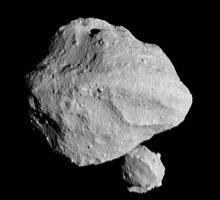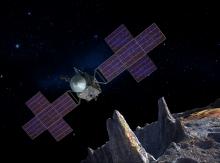Listen to today's episode of StarDate on the web the same day it airs in high-quality streaming audio without any extra ads or announcements. Choose a $8 one-month pass, or listen every day for a year for just $30.
You are here
Mercury and Venus
Mercury and Venus, the Sun’s closest planets, huddle together in the twilight the next few evenings. They’re quite low in the west-northwest at sunset. Venus is by far the brighter of the two. Mercury stands to its the upper left for the next few nights, then just a whisker away from it on Saturday.
The two planets have that region of the solar system mostly to themselves. Over the last couple of years, though, astronomers have discovered some asteroids that share the space. One of them is the first asteroid whose orbit stays completely inside Venus’s orbit.
In January 2019, a telescope in California spied an asteroid now called 2019 AQ3. Its orbit carries it from just outside Venus’s orbit to just inside Mercury’s. It comes to within a few million miles of each planet.
A year later, the same telescope recorded another asteroid, 2020 AV2. And it stays completely inside Venus’s orbit.
That won’t always be the case, though. The asteroid came from the asteroid belt, which is beyond the orbit of Mars. The gravity of the planets and other asteroids pushed AV2 toward the Sun. Over the next few million years, similar nudges will continue to alter its orbit — at times pushing it beyond Venus and toward Earth’s orbit.
One simulation suggests the asteroid will end its life in a few million years. It will slam into one of the inner planets — most likely Venus — leaving the inner solar system a bit emptier.
Script by Damond Benningfield






